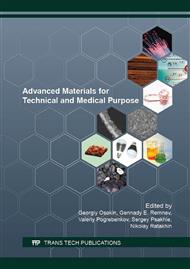p.182
p.188
p.195
p.200
p.205
p.211
p.215
p.220
p.226
The Structure of Quaternary Iron-Based Alloy Obtained at High and Ultrahigh Cooling Rates
Abstract:
Influence of Fe-Si-Al-C alloy cooling rate on its phase composition, structure and microhardness is shown based on metallographic investigations, electron microscopy and x-ray diffraction analysis. It was determined that the structure will change from dendrite to grained, size of structure elements will decrease, quantity and size of secondary phases precipitations will decrease when cooling rate changes from 103 to 107 K/s. The metastable phases such as primary ferrite, austenite and complex carbides are formed in cooling rate range. The volume ratio of main phases changes in favor of primary ferrite with cooling rate increasing. Hardening of the material occurs more than twice. Hardening is due to the interaction of solid-solution hardening, grain boundary hardening and dispersive hardening by secondary phases particles. The maximum hardening is achieved during formation of the alloy in molten pool at electron-beam melting. The alloy in this case contains 80 vol. % of austenite with dendrite similar structure and precipitations of carbide and silicocarbide phases. It can be assumed than such structure will be formed from the alloy with investigated composition at additive manufacturing.
Info:
Periodical:
Pages:
205-210
Citation:
Online since:
September 2016
Price:
Сopyright:
© 2016 Trans Tech Publications Ltd. All Rights Reserved
Share:
Citation:


